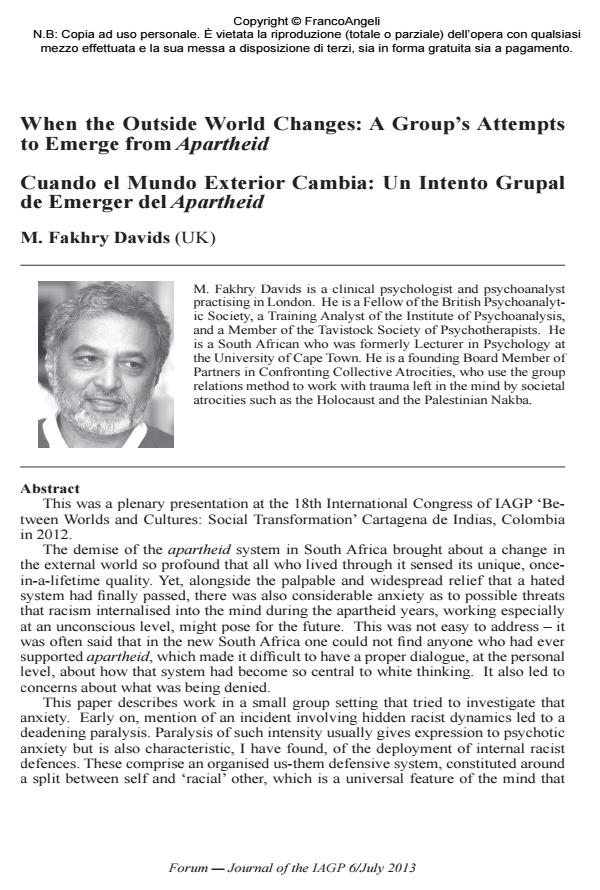When the Outside World Changes: A Group’s Attempts to Emerge from Apartheid
Journal title FORUM
Author/s M. Fakhry Davids
Publishing Year 2014 Issue 2013/6
Language Italian Pages 21 P. 13-33 File size 836 KB
DOI 10.3280/FORU2013-006005
DOI is like a bar code for intellectual property: to have more infomation
click here
Below, you can see the article first page
If you want to buy this article in PDF format, you can do it, following the instructions to buy download credits

FrancoAngeli is member of Publishers International Linking Association, Inc (PILA), a not-for-profit association which run the CrossRef service enabling links to and from online scholarly content.
This was a plenary presentation at the 18th International Congress of IAGP ‘Between Worlds and Cultures: Social Transformation’ Cartagena de Indias, Colombia in 2012. The demise of the apartheid system in South Africa brought about a change in the external world so profound that all who lived through it sensed its unique, oncein- a-lifetime quality. Yet, alongside the palpable and widespread relief that a hated system had finally passed, there was also considerable anxiety as to possible threats that racism internalised into the mind during the apartheid years, working especially at an unconscious level, might pose for the future. This was not easy to address - it was often said that in the new South Africa one could not find anyone who had ever supported apartheid, which made it difficult to have a proper dialogue, at the personal level, about how that system had become so central to white thinking. It also led to concerns about what was being denied. This paper describes work in a small group setting that tried to investigate that anxiety. Early on, mention of an incident involving hidden racist dynamics led to a deadening paralysis. Paralysis of such intensity usually gives expression to psychotic anxiety but is also characteristic, I have found, of the deployment of internal racist defences. These comprise an organised us-them defensive system, constituted around a split between self and ‘racial’ other, which is a universal feature of the mind that can be mobilised to deal with anxiety - in the group’s case, underlying anxiety about change itself. It was not this anxiety that paralysed the group. Instead, it stemmed from an unconscious belief that the racialised defence was necessary for protection, which generates unbearable guilt and a fear of retribution. The intensity of these emotions and the paralysis they engendered stem from the racialised defence being located at a primitive level of functioning in the mind. Despite the intensity, the theoretical understanding that it occurs within a normal rather than psychotic mind made it possible to address the paralysis in a direct and ordinary way. This approach provided an opportunity to engage directly the defensive system in which the racist object relationship is located. Splitting became the group’s dominant defence, recreating an apartheid mindset in the here-and-now but the facilitator’s capacity to contain, by verbalising accurately what was being projected, enabled the group to work with the projections. I bring forward moving material that shows unconscious recognition of the fact that the group had traversed this apartheid terrain in its own short history, as well as its pain at losing such a containing space, seen as precious in a changing world that generates considerable anxiety and in which the regressive pull to a racialised defence is ever-present. Would its members, as individuals, be able to take forward into the world the learning from the group, or would they succumb to the unconscious pull of the radicalised defence?
M. Fakhry Davids, When the Outside World Changes: A Group’s Attempts to Emerge from Apartheid in "FORUM" 6/2013, pp 13-33, DOI: 10.3280/FORU2013-006005